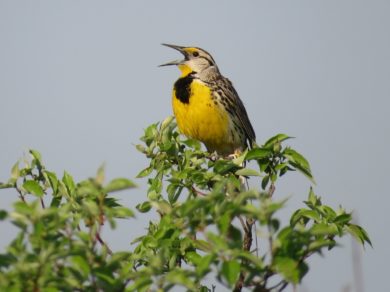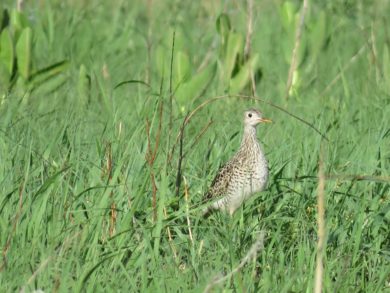
Eastern Meadowlark with a GPS geolocator – look carefully below it to see the black antenna hanging down. / © Jason Hill
One year ago, 40 Eastern Meadowlarks and Upland Sandpipers became aerial backpackers. Their tiny backpacks acquired and logged GPS locations that have tracked their movements during the past year. Now, the birds have returned to their breeding grounds where it all started and the location data from the entire year were beamed up to Argos satellites and delivered to our laptops at VCE.
Thanks to a grant from the DoD Legacy Program, VCE has been using GPS geolocators to determine the migration paths and wintering grounds of grassland birds across their breeding ranges. Battery size limits how many locations can be transmitted, so units are programmed to acquire locations once every week or two. After one year the data are transmitted all at once to Argos satellites. The wait has been long, but we finally received the data.
We’re just starting to examine the data, but the insights into their annual cycle will be remarkable for science and conservation. Of the 40 GPS tags deployed last year, we have data from 16 birds. Of those, a few appear to be barely-moving birds that remained in a very small area all year – in other words, the bird may have died or dropped its backpack. In other cases the tags failed to collect locations on all of the dates. Other tags, however, are biologists’ gold. These data will tell us new stories about the movements and wintering areas of these declining bird populations.
The short- to mid-distance migration of Eastern Meadowlarks provides a contrast to the hemispheric travels of the Upland Sandpiper. Some meadowlarks may remain on the breeding grounds year-round while others travel as far as Panama. Upland Sandpipers venture much farther, well into South America, to Argentina and Uruguay.

Upland Sandpiper on its breeding territory. / © Jason Hill
In the world of “cutting edge” geolocator technology, both rewards and drawbacks are part of the effort. To our knowledge, this is the first time these species’ migrations have been tracked so precisely. For birds the size of meadowlarks, the technological feat of GPS tracking was not even possible just two years ago.
An Early Teaser
Our newly acquired data show several Upland Sandpipers wintering in regions well outside what has been considered their core range. More details are to come once we further analyze the long-awaited data.

This is such exciting science! I never thought to look at all those E. Meadowlarks I recently saw in TX to see if there were backpacks attached! Now that Jason has perfected the technique of meadowlark capture, I hope there is more data to come.
There are no more data for this particular project, but this is hopefully a first (and giant!) step in meadowlark migration patterns using geolocation.